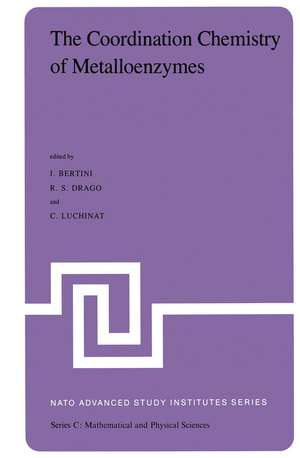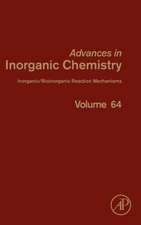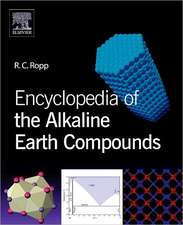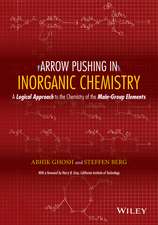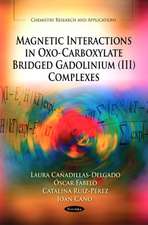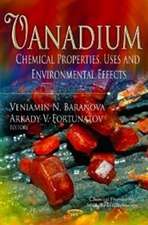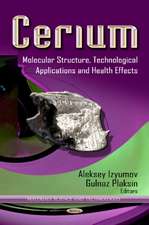The Coordination Chemistry of Metalloenzymes: The Role of Metals in Reactions Involving Water, Dioxygen and Related Species: Nato Science Series C:, cartea 100
Editat de I. Bertini, R. S. Drago, C. Luchinaten Limba Engleză Hardback – 31 ian 1983
| Toate formatele și edițiile | Preț | Express |
|---|---|---|
| Paperback (1) | 950.21 lei 6-8 săpt. | |
| SPRINGER NETHERLANDS – 2 noi 2011 | 950.21 lei 6-8 săpt. | |
| Hardback (1) | 957.13 lei 6-8 săpt. | |
| SPRINGER NETHERLANDS – 31 ian 1983 | 957.13 lei 6-8 săpt. |
Din seria Nato Science Series C:
- 24%
 Preț: 797.66 lei
Preț: 797.66 lei - 18%
 Preț: 957.62 lei
Preț: 957.62 lei - 18%
 Preț: 1227.52 lei
Preț: 1227.52 lei -
 Preț: 396.40 lei
Preț: 396.40 lei -
 Preț: 403.75 lei
Preț: 403.75 lei - 18%
 Preț: 1239.37 lei
Preț: 1239.37 lei - 18%
 Preț: 1236.51 lei
Preț: 1236.51 lei - 18%
 Preț: 1231.78 lei
Preț: 1231.78 lei - 18%
 Preț: 1229.10 lei
Preț: 1229.10 lei - 18%
 Preț: 1835.21 lei
Preț: 1835.21 lei - 24%
 Preț: 1076.36 lei
Preț: 1076.36 lei -
 Preț: 390.46 lei
Preț: 390.46 lei -
 Preț: 369.63 lei
Preț: 369.63 lei - 18%
 Preț: 1232.41 lei
Preț: 1232.41 lei -
 Preț: 394.51 lei
Preț: 394.51 lei - 18%
 Preț: 1226.24 lei
Preț: 1226.24 lei - 18%
 Preț: 1845.80 lei
Preț: 1845.80 lei -
 Preț: 399.88 lei
Preț: 399.88 lei -
 Preț: 384.28 lei
Preț: 384.28 lei -
 Preț: 390.88 lei
Preț: 390.88 lei -
 Preț: 381.19 lei
Preț: 381.19 lei - 18%
 Preț: 1848.64 lei
Preț: 1848.64 lei - 18%
 Preț: 951.14 lei
Preț: 951.14 lei - 18%
 Preț: 1230.35 lei
Preț: 1230.35 lei - 18%
 Preț: 1236.51 lei
Preț: 1236.51 lei -
 Preț: 401.03 lei
Preț: 401.03 lei -
 Preț: 406.25 lei
Preț: 406.25 lei - 18%
 Preț: 1230.84 lei
Preț: 1230.84 lei -
 Preț: 418.34 lei
Preț: 418.34 lei - 18%
 Preț: 1223.74 lei
Preț: 1223.74 lei
Preț: 957.13 lei
Preț vechi: 1167.23 lei
-18% Nou
Puncte Express: 1436
Preț estimativ în valută:
183.17€ • 187.58$ • 152.37£
183.17€ • 187.58$ • 152.37£
Carte tipărită la comandă
Livrare economică 19 martie-02 aprilie
Preluare comenzi: 021 569.72.76
Specificații
ISBN-13: 9789027715302
ISBN-10: 9027715300
Pagini: 416
Ilustrații: XIX, 391 p.
Dimensiuni: 155 x 235 x 28 mm
Greutate: 0.78 kg
Ediția:1983
Editura: SPRINGER NETHERLANDS
Colecția Springer
Seria Nato Science Series C:
Locul publicării:Dordrecht, Netherlands
ISBN-10: 9027715300
Pagini: 416
Ilustrații: XIX, 391 p.
Dimensiuni: 155 x 235 x 28 mm
Greutate: 0.78 kg
Ediția:1983
Editura: SPRINGER NETHERLANDS
Colecția Springer
Seria Nato Science Series C:
Locul publicării:Dordrecht, Netherlands
Public țintă
ResearchCuprins
I: The Coordination Properties of the Active Site of Zinc Enzymes.- 1. Introduction.- 2. The Residues Coordinated at the Zinc Ion.- 3. The Acid-Base Properties of Coordinated Water.- 4. The Electronic Spectra of Cobalt (II) Derivatives.- 5. The Water 1H NMR Studies.- 6. The Implications on the Catalytic Mechanism.- II: Coordinated Solvent Molecules in Metalloenzymes and Proteins Studied Using NMRD.- 1. Introduction.- 2. The “Fluoromet” Mechanism.- 3. Fe3+ — Transferrin.- 4. Cu2+ — and V02+ — Transferrin.- 5. Co2+ — Carbonic Anhydrase.- 6. Alcohol Dehydrogenase.- 7. Mn2+ — Carboxypeptidase A.- 8. Conclusions.- III: 113Cd Nuclear Magnetic Resonance Studies of Zinc Metalloproteins.- 1. Introduction.- 2. Chemical Shifts.- 3. Sensitivity.- 4. Information Content.- 5. Concluding Remarks.- IV: Carbonic Anhydrase: Structure, Kinetics, and Mechanism.- 1. Introduction.- 2. Structure.- 3. Kinetics.- 4. Mechanism.- V: Metal Ion Promoted Hydrolysis of Nucleoside 5’-Triphosphates.- 1. Introduction.- 2. Results and Discussion.- VI: Models of Metalloenzymes: Carboxypeptidase A.- 1. Introduction.- 2. Metal Ion Catalyzed Hydrolysis of Amides and Esters.- 3. Results and Discussion.- 4. Cu2+ Mediated Amide Hydrolysis.- 5. Conclusions.- VII: Spectroscopic Studies on Cobalt(II) Carboxypeptidase A.- VIII: Coordination Properties and Mechanistic Aspects of Liver Alcohol Dehydrogenase.- 1. Introduction.- 2. Coordination Chemistry of Metallo Alcohol Dehydrogenases.- 3. Mechanistic Aspects.- IX: Metal-Directed Affinity Labelling and Promoted Alkylation of a Thiol Liganded to the Catalytic Metal Ion in Liver Alcohol Dehydrogenase.- 1. Introduction.- 2. Experimental.- 3. Results and Discussion.- X: Ligand Sphere Transitions: A New Concept in Zinc-Enzyme Catalysis.- 1. Introduction.-2. Experimental Background.- 3. The Proposed Model Concept.- XI: Molecular Mechamisms of the Superoxide Dismutase Activity of the Cuprozinc Protein of Eucaryotic Cells (CuZn Superoxide Dismutase).- 1. Molecular Properties of the Protein.- 2. General Mechanism of the Superoxide Dismutation by the Copper of the Protein.- 3. Inactivation of the Enzyme.- 4. Inhibition of the Enzyme.- 5. Role of the Zinc.- XII: A Comment on Anion Binding to Superoxide Dismutase.- XIII: Kinetic and Magnetic Resonance Studies on Amine Oxidases.- 1. Introduction.- 2. Studies on the Copper Cofactor.- 3. Mechanistic Studies.- XIV: Metal Coordination and Mechanism of Blue Copper Containing Oxidases.- 1. Introduction.- 2. Chemical Composition and Reactions Catalyzed.- 3. Spectroscopic Data.- 4. Oxidation-Reduction Properties.- 5. The Catalytic Mechanism.- XV: Metal Replacement Studies of Chinese Laccase.- 1. Introduction.- 2. Metal-Replacement Studies of Small Blue Proteins.- 3. The Removal and Replacement of Copper from Chinese Laccase.- 4. The Preparation of a Mixed-Metal Hybrid of Laccase.- XVI: Reactions of Rhus Vernicifera Laccase with Azide and Fluoride, Formation of a “Half-Met-N3 –Type” Binding.- 1. Reactions with N3- as Studied by EPR.- 2. Reactions with N3- in the Presence of Redox Reagents.- 3. Half-Met-N3-Type Binding in Laccase.- 4. Reactions with Fluoride.- 5. Temperature Effects.- XVII: Structural Magnetic Correlations in Exchange Coupled Systems.- 1. Spin Hamiltonian Approach to Exchange Coupling.- 2. Molecular Orbital Approach to Exchange Coupling.- XVIII: Structural and Magnetic Investigations on Model CU4O4 Cubane-Like Clusters.- 1. Introduction.- 2. Structural Description.- 3. Magnetic Properties and Structural Data.- 4. Extension of the Correlations Between Magnetism andStructures.- 5. Example.- XIX: Neurospora Tyrosinase: Intrinsic and Extrinsic Fluorescence.- 1. Introduction.- 2. Intrinsic Fluorescence.- 3. Extrinsic Fluorescence.- XX: Comparison of Two Fungal Tyrosinases.- 1. Introduction.- 2. Molecular Properties.- 3. Properties of the Copper Site.- 4. Identification of Endogenous Ligands.- 5. Inhibition by Anions.- XXI: Activation of Molecular Oxygen.- 1. Introduction.- 2. Autoxidation Reactions.- 3. Wacker Oxidations.- 4. Oxidations by Metal Bound 02.- 5. Oxidations by Products Derived from Metal-O2 Species.- 6. Oxygen Atom Transfer Reactions.- 7. Conclusion.- XXII: Mössbauer Studies on Putidamonooxin — A New Type of [2Fe-2S] Containing Oxygenase Component with a Mononuclear Non-Heme Iron Ion as Cofactor.- 1. Introduction.- 2. Mössbauer Spectroscopic Investigation.- 3. Conclusion.- XXIII: The Enzyme-Substrate Interaction in the Catechol Dioxygenases.- XXIV: Ferric Nitrilotriacetate: An Active Center Analogue of Pyrocatechase.- XXV: Stereoselective Peroxidatic Activity of Iron(III) Complex Ions Supported on Polypeptides.- XXVI: NMR Studies of Cytochromes.- 1. Introduction.- 2. Class II Cytochromes c.- 3. Low Spin Cytochromes.- 4. Electron Transfer Mechanisms.- XXVII: The Structure of the Metal Centers in Cytochrome c Oxidase.- 1. Introduction.- 2. The Metal Centers.- 3. Summary.- XXVIII: Models of Metalloenzymes: Peroxidase and Cytochrome P-450.- 1. Introduction.- 2. Model Systems.- XXIX: Coordination Chemistry of Cytochrome P-450 and Herne Models.- 1. Introduction: Occurrence and Function of Cytochrome P450-Dependent Monooxygenases.- 2. The Catalytic Cycle of Cytochrome P450.- 3. Cytochrome P450-Iron Comlexes Formed by Direct Interaction with Organic Compounds.- 4. Cytochrome P450-Iron-Metabolite Complexes.- 5. Conclusion:The Unique Richness of Cytochrome P450 Coordination Chemistry.- XXX: Mössbauer Studies of Synthetic Analogues for the Active Site in Cytochromes P450.- 1. Introduction.- 2. Preparation of the Compounds.- 3. X-ray Structures.- 4. Mössbauer Studies.- 5. Molecular Orbital Calculations and ?EQ- Interpretation.- XXXI: Magnetic Circular Dichroism Spectroscopy as a Probe of Ferric Cytochrome P-450 and its Ligand Complexes.- 1. Introduction.- 2. Materials and Methods.- 3. Results and Discussion.- 4. Conclusion.
